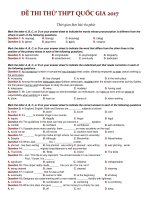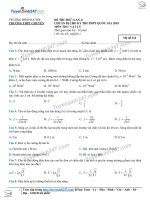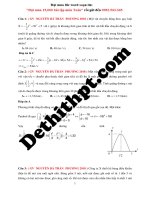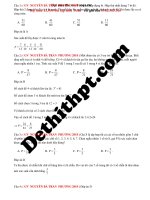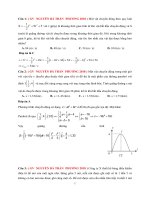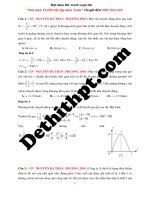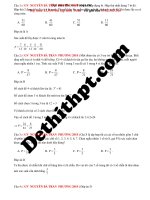Cs224W 2018 19
Bạn đang xem bản rút gọn của tài liệu. Xem và tải ngay bản đầy đủ của tài liệu tại đây (9.93 MB, 17 trang )
CS
224W
FINAL PROJECT: QUASIRANDOMNESS AND SIDORENKO’S
CONJECTURE IN DIRECTED NETWORKS
NITYA MANI
1.
INTRODUCTION
1.1. Context. A challenging and important question in network analysis is counting the
number of copies of some motif B in some larger graph G as a way to featurize a graph
for downstream learning tasks on the network, understand fundamental graph theoretic
properties of G or make predictions about how far from random G is.
The associated fundamental extremal graph theory question is estimating the minimum
number of copies of subgraph B in any graph G on a fixed number of vertices and edges.
As a special case, one very famous class of graph theory questions is the set of Turdn-type
problems, asking how many edges a graph G on a fixed number of vertices must have to
guarantee it has at least one copy of fixed subgraph B. Special cases (B as a triangle, clique)
were resolved by Turan, Mantel, and dramatically generalized to an asymptotic answer for
all non-bipartite fixed subgraphs B by the Erdés-Stone-Simonivits Theorem. Although a
variety of upper bounds have been shown for bipartite B, a tight bound for all bipartite B
has eluded mathematicians for over a century.
Questions about motif counts in networks can be very naturally posed as questions about
the density of fixed subgraphs in larger graphs. We often understand graphs G on E(G)
vertices and V(G) edges via their edge density, p = E(G)/ (©), Here we consider more
generally the B-density of a graph G, the fraction of injective vertex maps p: V(B) > V(G)
that send edges to edges. Each such map p gives
N and edge density p, we often wish to compute
We obtain an upper bound on this quantity by
random graph. In such G, the minimum possible
a distinct labeled copy of B in G. For fixed
minimum possible B-density in graphs G.
taking G = G(N,p) to be an Erdos-Renyi
B density is at most p!?)!,
1.2. Motivation. With respect to this formulation, one of the primary motivating questions
for all of extremal graph theory for the past several decades has been Sidorenko’s conjecture,
the surprising result that the above upper bound on the minimal B-density in graphs G is
sharp when B is bipartite. More precisely, this conjecture jointly posed by Erd6és-Simonivits
[12] and Sidorenko [11] proposes that for any bipartite graph B on m edges, there exists
some constant «(B) > 0 such that the number of copies of motif B in any graph G on N
vertices (for sufficiently large N with edge density p > N~‘)) is at least p!?(?)|NIV®)!, the
expected number of copies of B in the Erdos-Renyi random graph G(N, p).
The above presentation of Sidorenko’s conjecture immediately suggests its relevance to
making sense of graphlet and motif counts in networks, and to understanding features of networks that may seem surprising at first glance. However, beyond the potential for Sidorenko’s
Figure 1. Digraph G on 5 vertices (left), B = C} (middle), tournament on 3
vertices B’ (right). The B-density of G is 75 and the B’-density is x.
1
2
NITYA
MANI
conjecture to inform motif-based node featurization, it also has a wide variety of applications
to random matrix theory, Markov chains, and understanding quasirandomness.
Quasirandom graphs were first studied by Thomason, and Chung-Graham-Wilson [2] who
observed that a large number of properties that Erdos-Renyi random graphs satisfy are
actually equivalent. Such properties can be used to understand one of the primary motivating
questions in network analysis: “How close to random is a given network G?” Understanding
deterministic graph constructions that have such properties (i.e. quasirandom graphs) can
be useful as a benchmark when wondering whether features of a network are idiosyncratic
or expected based on its fundamental characterization.
The notion of quasirandomness also leads to a strengthening of Sidorenko’s conjecture. A
graphlet B is forcing if a family of graphs {G,,}°°, is quasirandom if and only if the number
of copies of B in G, is asymptotically the number achieved in the Erdos-Renyi graphs of
density matching G,. As an example, we can take B = C;, (a cycle of length 4), a motif
shown to be forcing. C4 is forcing is the statement that a family of graphs {G,,}°2, with edge
density p is quasirandom (i.e. behaves like G(n, p) for most mathematical and computational
purposes) if and only if it’s Cy density is roughly p*. The forcing conjecture, initially posed
by Skokan and Thoma [13] states that graphlets B are forcing if and only if they are bipartite
and contain a cycle (showing these conditions are necessary is straightforward). The forcing
conjecture would yield a short certificate of a graph behaving “like random.”
While an extensive effort has gone in over the past decades to resolving parts of Sidorenko’s
conjecture, the forcing conjecture, and related extremal claims about networks, the analogues
of these problems for directed or oriented networks have gone largely unstudied. In fact,
apart from developing an analogous characterization of quasirandomness in directed graphs,
as in [3], little work has been done to investigate extremal questions concerning directed motif
counts. This problem is substantially more challenging, with very limited understanding of
what directed analogues of the above two conjectures are likely to be true.
1.3. Contribution Overview. Here, we present an original characterization of a directed
Sidorenko conjecture and a directed forcing conjecture and show necessary conditions on
directed motifs to satisfy these results. We relate these characterizations to the undirected
analogues and show the limitations of reductions of directed problems to undirected graphs?.
1.4. Outline. We proceed as follows through this article. We begin by stating our main
results in Section 2. In Section 3, we review notational preliminaries used throughout the
article. In Section 4, we recall previous literature on undirected Sidorenko, forcing results,
motif counting, and quasirandomness in directed networks. Armed with this background, we
give a broader characterization of quasirandom directions in directed networks in Section 5.
These results about quasirandom orientations enable us to state results about directed forcing
motifs. In Section 6, we present a natural directed forcing conjecture and give context and
motivation for Theorem 2.4 and Theorem 2.4. We tackle directed Sidorenko in Section 7.
We set up a symmetric and asymmetric directed Sidorenko conjecture and present several
relationships between the directed and undirected conjectures, motivating our major results
Theorem 2.3 and Theorem 2.5. Finally, we discuss some remaining open problems ripe for
future investigations, give applications of our work, and conclude in Section 8.
'T was approved to do a purely theoretical graph theory project by Prof. Leskovec and thus do not have
a Github repository. However, I do illustrate the results with a few toy graphs pictured throughout and
discuss applications of these theorems in Section 8.
DIRECTED
2.
SIDORENKO
+ QUASIRANDOMNESS
STATEMENT
OF
3
RESULTS
We show several state-of-the art results, making substantial progress towards understanding directed motif counts in “like-random” directed graphs and lower bounds on the counts of
families of directed motifs in all directed graphs. All of our novel contributions are collected
below, but relevant notation may only be introduced later in the article (c.f. Section 3); we
repeat the results in context after showing the necessary intermediate results and defining
all relevant quantities precisely.
We first give an expanded characterization of quasirandom orientation in directed graphs
of independent computational interest.
Theorem 2.1. For a digraph G = (V, E) on n vertices andm = Q(n?) edges with underlying
undirected graph H, the following are equivalent:
(1) r(G) = o(m)
(2) 7*(G) = o(m)
(3)
N(CY, G)
=
(5
+ o(1))
N(C4,
E for vertices v1, V2, 03,04 © V
H),
where
Cy
=
{(v1,
V2),
(v3, Đa),
(v3,
V4),
(v1, U4) $
c
(4) For any labeling L ofV and all B, N,(B,G) = (27\"! + 0(1)) Ni(B, H)
(5) For any even k > 4, Ex(G) = (5 + 0(1)) Nz(Cy, H)-
(6) For any even k > 4, Tr(A(G)*) = 0(Tr(A(H)*)))
(7) |À(G)| = oA(H)))
If any of these conditions is satisfied, G has quasirandom direction with respect to H.
We give a broad, infinite family of directed motifs B such that counting the copies of B in
any directed graph G completely characterizes whether or not any tournament (orientation
of a complete graph) has spectral and structural properties that cause it to behave “like
random” for almost any computational purpose.
Theorem 2.2. [f B= (V,E) is a transitive directed graph such that the underlying graph
B satisfies the asymmetric forcing property then for any tournament G, G has quasirandom
direction iff
ta(G) = (u(B) + o(1))
We also give a broad infinite family of directed motifs B that are overrepresented in all
tournaments, relative to randomly orienting the edges of a complete graph:
Theorem 2.3. Let B = (B,U Bs, F’) be any bipartite digraph such that for all e = (by, bs) €
F, b, € By,b2 € By with underlying undirected graph B. Then for any tournament G =
(V, EF), ifB satisfies asymmetric Sidorenko’s conjecture, we have a Sidorenko-style bound:
ta(G) = w(B)
More generally, we are also able to give strong necessary conditions for any directed motif
to have a directed Sidorenko property or be forcing for general directed graphs:
Theorem
2.4. If a digraph B = (V,E) that satisfies |V| = b > (4(1 + 6))'*"” and |E| >
(1+ €)b for any fixed € > 0 is not transitive, it is not forcing.
We show a necessary condition for a directed motif to be overrepresented:
Theorem
2.5. Any digraph B satisfying the directed Sidorenko property must be transitive.
4
NITYA
3.
NOTATIONAL
MANI
PRELIMINARIES
Throughout, all directed graphs (abbreviated as digraphs) are assumed to be unweighted,
oriented graphs (i.e. with no parallel or antiparallel edges and no self-loops). Unless, other-
wise specified, we let G = (V, F) be a digraph with |V| =n vertices and |E| = m edges. We
will be interested in the undirected graph associated to G:
Definition 3.1. For a digraph G = (V, E), we define the underlying undirected graph H =
(V, F) where for each edge v + w = (v,w) € E we have an undirected edge (v, w) € F.
For a digraph G = (V, E) and vertices a,b € V, let (a,b) € E be the edge directed a =>
For subsets A, B C V, let
b.
e(A, B) = |{e
= (a,b) CE
| ac A, be B}|
denote the number
edges directed from vertices in A to vertices in B and vice versa for
e(B, A). For a vertex v € V, let d*(v) be the indegree of a vertex v € V, ie.
d*(v) =|{w eV | (w,v) € E}],
and similarly let d~(v) denote the outdegree of v. We let d*(v, S'), be the indegree into S of
v:
d*(v,8) = |{w € S|(w,v) € E}|
and similarly let d~(v,S) be the outdegree into S of v.
Definition 3.2. Given a graph G = (V, E), for two subsets A, B C V we define
T(G) = Imax (e(A, B) — e(B, A)),
T*(G) := "-.. `...
B) —e(B,A)).
We can also similarly define the maximal edge difference for partitions:
THE)G)= gp
gh
A, B)—e(B,A
B)— ee, A)
Note 7* is not always achieved by a partition although 7,(G) < 7*(G).
A motivating question is counting directed motifs in graphs, which we do in 2 ways:
Definition 3.3. For digraph G = (V, £) with underlying undirected graph H and a digraph
B (with undirected underlier B), let N(B,H), be the number of copies of B in H and
N(B,G) be number of copies of B in G. For a labeling L : V — [n] of the vertices, let
N,(B,H) be the number of labeled copies of B in H and let Nz(B,G) be the number of
labeled copies of B as a subgraph of G. In other words, N counts graphlets once and Nz;
counts graphlets as many times as there are automorphisms.
In the introduction, we articulated Sidorenko’s conjecture and the forcing conjecture in
the language of motif counts and densities. In practice, we will work with a far more flexible
and useful characterization of these conjectures in the language of homomorphism densities
(we can do this at the same time for directed and undirected networks):
Definition 3.4. A graph homomorphism B —> G is a map p: V(B) + V(G) such that if
(v,w) € E(B), then (p(v), p(w)) € E(G) (i.e. p maps edges to edges). The homomorphism
density of B in G, denoted tg(G) is the fraction of vertex maps that are homomorphisms:
hp(G)
tp(G) = IV(@|Y:
DIRECTED
SIDORENKO
+ QUASIRANDOMNESS
5
Figure 2. Transitive 5-vertex (left) and 4-vertex tournament (right)
where hg(G) is the number of homomorphisms B > G.
Homomorphisms are not necessarily injective, multiple vertices of B can map to the same
target vertex in G. The classical Sidorenko’s conjecture is just the following:
Conjecture 3.5 (Sidorenko’s Conjecture). For every bipartite undirected graph A with m
edges and every undirected graph H (we denote an edge by K2),
ta(H) > tr,(H)P
We consider oriented graphs in general, but many of our results focus on a specific family
of directed graphs, the so-called tournaments (directed cliques):
Definition 3.6. A tournament on n vertices is a digraph T = (V, #) with |V| = n such that
for every pair of vertices {v, w} exactly one of (v, w), (w,v) € E.
4.
PREVIOUS
WORK
4.1. Sidorenko’s conjecture. Beyond the initial observations that Sidorenko’s conjecture
held for cycles, one of the most substantial steps was taken by Conlon, Fox, and Sudakov in
“An approximate version of Sidorenko’s conjecture” [4]. First, they showed Conjecture 3.5
held when A = (V; U Va, E) was a bipartite undirected graph with a vertex with an edge to
every node in the other part. They also proved an approximate version of Conjecture 3.5
and the forcing conjecture for a family of bipartite graphs A.
4.2. Quasirandom tournaments. The above literature deals exclusively with extremal
results for motif counts and quasirandomness properties for undirected graphs. The study of
such questions in directed graphs is severely limited. Chung and Graham, who first introduced quasirandomness in undirected graphs, also gave a characterization of quasirandom
tournaments (directed cliques). They posed a natural question: “Given a tournament, how
is it possible to tell if the tournament and its properties behave like-random or have some
special features?” They gave an analysis of several equivalent properties that are all shared
by random tournaments in [3] (i.e. given by uniformly at random picking one of the two
possible orientations of each edge in a clique).
They gave 11 equivalent properties that provide a short certificate that a given explicit
tournament has “random-like” behavior in contrast to checking such properties for an instantiation of a random tournament. This work was later generalized in [7] to give spectral characterizations of quasirandom tournaments. In both cases, progress was limited to
quasirandomness for this special family of directed graphs without describing forcing or
Sidorenko-style properties that may or may not hold for directed motifs in tournaments.
6
NITYA MANI
4.3. Quasirandom orientation. In 2013, Griffiths gave a presentation of quasirandom
orientations on a general directed graph in [6]. He focused on showing analogues of the
properties described in [3] for oriented and partially oriented graphs.
In the process, Griffiths was able to show the first forcing results for directed graph, by
showing that two orientations of an undirected 4-cycle were forcing (one where two vertices
have out-degree 2 and the other 2 have in-degree 2 (C;”), and another orientation given as
a directed cycle with a single flipped edge). In the process, he also concluded that the other
two (up to isomorphism) orientations of a 4 cycle would not satisfy a forcing conjecture.
This limited result highlights how much more difficult the problems of forcing and Sidorenko
style bounds are for directed graphs than for undirected graphs. This paper is limited to
showing forcing for these two very specific subgraphs and falls short of any Sidorenko-style
analysis or forcing claims even for slightly larger cycles (such as for orientations of a 6-cycle).
5. QUASIRANDOM
DIRECTIONS
Throughout, we let G = (V, F) be a digraph on |V| = n vertices and |E| = m edges. We
use T(G) and labeled counts of copies of subgraphs to characterize graphs with quasi-random
directions, as introduced in [3] and extended to all digraphs in [6].
We consider properties that a dense digraph G = (V, EF) on n vertices and m = Q(n 2
vertices might satisfy. We use the asymptotic o(-) notation loosely. If P = P(o(1)),Q =
Q(o(1)), then P = > Q means that for each € > 0, for some sufficiently large n > N(e),
there exists 6 so that if G satisfies Q(d) then it satisfies P(e).
Definition 5.1. For a digraph G = (V, F) on n vertices, the adjacency matrix A is ann x n
adjacency matrix with rows and columns indexed by vertices so that
Aw=
1
4-1
(uv)EF
(v,u) EE
0
else
These definitions will allow us to give an expanded characterization of Theorem 2.1, replicated below. We defer the proof of Theorem 2.1 to Appendix A
Theorem. For a digraph G = (V,E) on n vertices and m = Q(n?)
undirected graph H, the following are equivalent:
(1) r(G) = o(m)
(2) 7*(G) = o(m)
(3) oan
G) = ($+ o(1)) WC
edges with underlying
HD), where Ci = {(v1, v2), (v3, V2), (V3, V4), (V1, vs) } C EB
or vertices V1, V2, U3, U4 EV.
(4) For any labeling L of V, Nz(B,G) = (2-”®)! + o(1)) Nz (B, H)
(5) For any even k > 4, Tr(A(G)*) = o(Tr(A(H)*)))
(6) |As(G)| = o(|A1(4)))
If any of these conditions is satisfied, G has quasirandom direction with respect to H.
Being quasirandom endows a digraph with a tremendous amount of structure. As an
illustration, in Appendix A we also show the implications of quasirandomness for a directed
graph being almost-balanced: \~,.,, u€V |d*(v) — d~(v)| = o(m).
DIRECTED
SIDORENKO
6. FORCING
+ QUASIRANDOMNESS
ORIENTED
7
GRAPHS
We recall the classical definition of quasirandom undirected graphs via forcing subgraphs,
related to the characterization of Theorem 2.1
Definition 6.1. A sequence (H, :n = 1,2,...) of undirected graphs is called quasirandom
with density p (where 0 < p < 1) if, for every graph A,
fA(Hu) = (1+ ø(1))p 9},
ta(H)
_—_
hẠ(H)
— gi?
1s the fraction of mappings ƒ : V(4) —> V(H) which are homomorphisms.
The above definition gives rise to p-forcing subgraphs, individual subgraphs that guarantee
quasirandomness. This is made more precise below:
Definition 6.2. A graph A
with density p only if
A graph A
is p-forcing if a sequence of undirected graphs H,, is quasirandom
ta(Hn) = (1 + o(1))p*
is said to be forcing if it is p-forcing for all p.
Conjecture 6.3 (Forcing Conjecture).
bipartite and contains a cycle.
An undirected graph A is forcing if and only if it is
We also consider the directed analogue of forcing subgraphs, as in [4]. To do this, we will
first need to understand the symmetries of digraphs:
Definition
6.4.
On a vertex labeled digraph B with underlying undirected graph H, we
define ju(B) as the fraction of directed graphs with underlying graph H isomorphic to B (i.e.
the fraction of orientations of H that yield digraphs C’ that there exists a vertex isomorphism
V(C) = V(B) mapping edges to edges). Note that
Aut(H)
M(B) = By
1a
where Aut(H) counts the labeled automorphisms of undirected graph H and o(B) counts
the number of symmetries of digraph B.
Example.
Cg oriented so all edges go from one part to the other, termed C%”, has u(C5”) =
2/25 = 1/32, whereas Cg oriented as two length three paths has p(C%) = 6/2° = 3/32.
Definition
only if
6.5. For any digraph G = (V,£), a digraph B is forcing if G is quasirandom
ta(G) = (u(B) + o(1)) tie, (G)P
We say that a digraph is forcing for a family of digraphs (H,,)°, if for any digraph G, =
(V, E) with underlying undirected graph H,, as n + oo, G is quasirandom only if
te(Gn) = (u(B) + 0(1)) te, (Hn)?
This setup allows us to show Theorem 2.4 to give a necessary condition for a directed
motif to be forcing, replicated below. We defer the proof to Appendix B.
Theorem.
If a digraph B that satisfies |V(B)|
= b > (4(1 + ))'*"”* and |E(B)| > (1 +6)b
for any fixed € > 0 is not transitive, it 1s not forcing.
8
NITYA MANI
Further, if the underlying undirected graph B of transitive digraph B satisfies a stronger
asymmetric forcing property, then for any tournament G, G has quasirandom direction iff
tp(G) = (u(B) + o(1))
We prove this result (Theorem 2.2 and discuss asymmetric forcing further in Appendix B.
7.
THE
DIRECTED
SIDORENKO
CONJECTURE
Our characterization of quasirandom graphs is closely tied to
jecture, stated via graph homomorphisms in Conjecture 3.5.
questions for digraphs. Given undirected graph H = (V,F’), a
G = (V,E£) is given by taking for each (v,w) € F exactly one
uniformly at random.
the famous Sidorenko conWe consider the analagous
random orientation on H,
of (v,w),(w,v) to be in E
Conversely, for any digraph G = (V,£), let H = (V,F’) denote the
underlying undirected graph.
Definition 7.1 (Directed Sidorenko).
We define two Sidorenko-style properties for digraphs
B based on one of (7.1) and (7.2) for every digraph G = (V, E):
(7.1)
ta(G) > u(B)tn,(G@)|"! + o(1)
(7.2)
ts(G) > n(B)tg(H) + (1)
A digraph B has the directed Sidorenko property if for all digraphs G = (V, F), (7.2) holds.
Note that (7.2) implies (7.1) if the underlying graph satisfies Sidorenko’s conjecture. Thus,
the above definition captures a natural directed analogue of the Sidorenko property:
Proposition
7.2. If an undirected graph A does not have the Sidorenko property, then for
all orientations B of A, B does not satisfy (7.1).
Proof. Suppose undirected A does not have the Sidorenko property.
of graphs (H,,) for H = H,, (n sufficiently large), we have
ta(H) < tx,(H)!?
Suppose we randomly orient the edges of H to obtain G. Let B be a
The expected number of copies of B is (B)£A(H), implying that
Then, for some family
fixed orientation of A.
Elts(G)] = u(B)tA(H) < w(B)tc,(H)PO! = p(B)tc, (GP.
Therefore, there exists some digraph G such that tg(G) < u(B)tx,(G)|2™!, so B does not
satisfy (7.1). Since this holds for all orientation of A, we obtain the desired result.
a
As in Section 6, we can extend our setup to an asymmetric directed Sidorenko property.
We recall the classical undirected characterization and define a directed bound:
Definition 7.3. Bipartite undirected graphs B = (VjLIV2, E), |E| = m and H = (U, UU,
with edge density p =
ii
satisfy the asymmetric
F)
Sidorenko property if the density of
homomorphisms f : V(B) + V(G) such that f(V;) C U; for i = 1,2 is at least p™, ice.
tạ(H) > p”.
Bipartite directed graphs B = (V, U V2, E), |E| = m and G = (U; U U2, F) with edge
density p = wit
satisfy the directed asymmetric Sidorenko property if the density of maps
f : V(B) > V(G) such that f(V;) C U; for 7 = 1,2 which are homomorphisms is at least
p(B), in other words, tg(G) > p™u(B).
DIRECTED
SIDORENKO
+ QUASIRANDOMNESS
9
This characterization suggests a possible reduction that we give, showing that orientations
of undirected graphs that satisfy the asymmetric Sidorenko’s conjecture satisfy the Sidorenko
style-bound in tournaments of Theorem 2.3, replicated below and proved in Appendix C:
Theorem. Let B = (B, U Bo, F’) be any bipartite digraph such that for all e = (bị, ba) € F,
bịC By, by € By with underlying undirected graph B. Then for any tournament G = (V, F),
if B satisfies asymmetric Sidorenko’s conjecture, we have a Sidorenko-style bound:
tp(G) = p(B).
We also observe in Theorem 2.5 (proved in Appendix
directed Sidorenko property must be transitive.
8.
C) that any digraph B with the
DISCUSSION
8.1. Applications. Progress towards the directed Sidorenko and forcing conjecture such as
the results of Section 2 are of substantial interest to the computer science community. We
highlight three of numerous potential applications of such results.
8.1.1. Graphlet featurization. Making predictions in directed graphs often requires pre-processing
for featurization. Thus, learning effective whole-graph embeddings is of considerable interest
to those wishing to perform downstream machine learning tasks on graphs.
One common way of learning such embeddings is by embedding a graph into a feature space
with each entry comprising a motif count for a set of small graphlets, as discussed in lecture.
Often, we wish to understand the significance score of these graphlet counts in relation to
random graphs; we understand properties of the graph based on how positive or negative
such significance scores are. The directed Sidorenko conjecture would have the surprising
consequence that whichever directed graphlets satisfy a directed Sidorenko property will
never have negative expected significance score when comparing to an Erdés-Renyi random
graph. This implies that featurizations with such motifs lose more information than can be
expected, and inferring properties without this knowledge can lead to increased weight being
put on motif counts that are not as surprising as the Z-score may naively suggest.
8.1.2. Deterministic randomness. In many practical engineering problems, including circuit
design, building telecommunication networks, and understanding biomedical networks, we
often wish to have a reference “like-random” directed graph that we can guarantee has
desired good properties. Understanding pseudorandom directed graphs as we do in Theorem 2.1 provides short certificates for a deterministic graph to have “like random” behavior.
In addition, this analysis yields a deterministic method to construct “like-random” graphs
quickly with properties that make them good null models for experiments on real-world networks. Conversely, one of the necessary and sufficient conditions of quasirandom is given
by counts of forcing directed motifs. Knowing that a directed network is quasirandom thus
gives a rapid way to approximately enumerate directed subgraphs.
8.1.3. Motifs in tournaments. In addition to partial progress towards the general directed
Sidorenko and forcing conjectures, our progress above shows Sidorenko-style bounds for tournaments. Tournaments occur all over the Internet and world, from athletics to auctions to
Internet competitions, and our results enable such complete networks to be far better understood than they historically were. Specific applications include judging if participants in a
10
NITYA
MANI
Figure 3. C2 (left) and Cạ” (right).
chess or other tournament are over-qualified or cheating by assessing tournament randomness
and identifying sport-specific idiosyncrasies in round-robins.
Beyond these instances, understanding motif counts in directed graphs and short certificates of directed networks having “like-random” properties is of substantial interest to
computational biologists, network scientists, and a host of other computer scientists.
8.2. Open Questions. The directed Sidorenko and forcing conjectures are far more poorly
understood than their undirected analogues. Consequently, the progress highlighted in Section 2 represents state-of-the-art research results, implying that a number of relatively simpleseeming fundamental questions still remain open in the field. We introduce one such example:
Definition 8.1. Let directed cycle Cz be the directed graph on r vertices v1, ...U, comprising
edges (U1, V2),---(Up—1, Ur); (Up, U1).
Let
Cz? = (V UW, EF) be the bipartite digraph with
underlying undirected graph C2, so that for e = (v,w) € E,v € V andw
e W.
One major result in the area of motif counting is that all even-length undirected cycles
satisfy the undirected Sidorenko conjecture. However the analagous directed question is still
wide open, even for the very specific case of computing which (if any) orientations of a 6-cycle
are systematically overrepresented:
Question 8.2. Does the directed motif Cg”, consisting of an orientation of a 6-cycle where
consecutive edges go in opposite directions, satisfy the directed Sidorenko conjecture? Does
any orientation of a 6-cycle satisfy the directed Sidorenko conjecture?
More broadly, the broad problem our above results make progress towards is the following:
Question 8.3. Which directed motifs satisfy a directed Sidorenko and/or forcing conjecture?
Several of the methods highlighted in our partial results seem promising for making forward
progress towards this motivating question. Further, they highlight potential reductions from
directed graph questions to associated questions about undirected graphs where we can
leverage a better understanding of graphlet counts.
ACKNOWLEDGEMENTS
I would like to thank my thesis advisor Professor Jacob Fox for his invaluable help in learning probabilistic
graph theory. I would also like to thank him for several suggestions and references along the research process.
I would also like to thank Zoe Himwich,
with whom
I have been collaborating on two other graph theory
projects and who has helped me understand a variety of techniques in extremal graph theory.
like to thank Professor Leskovec and the CS 224W teaching team for their support.
I would also
DIRECTED
SIDORENKO
+ QUASIRANDOMNESS
11
REFERENCES
[1] O. Amini, S. Griffiths, and F. Huc, Subgraphs of weakly quasi-random oriented graphs, SIAM J. Discrete
Math. 25 (2011), 234-259.
[2| F. Chung, R. Graham, R. Wilson, Quasi-random graphs Combinatorica (1989), 345-362.
[3] F. Chung, R. Graham, Quasi-random tournaments J. Graph Theory (1991), 173-198.
[4] D. Conlon, J. Fox, and B. Sudakov, An approx. version of Sidorenko’s conjecture,
(2010).
Geom.
Fun. Anal. 20
[5] D. Dellamonica et al., Tree-minimal graphs are almost regular, J. Comb., 3 (2012), 49-62.
[6] S. Griffiths, Quasi-random oriented graphs, J. Graph Theory 74 (2013), 198-209.
[7] S. Kalyanasundaram
and A. Shapira, A note on even cycles and quasirandom tournaments,
Theory (2013), 260-266.
[8] J. Fox, P. Keevash, and B. Sudakov, Directed graphs w/o short cycles,
Comb.
Prob.
285-301.
[9] D. Mubayi and J. Verstraete, Counting trees in graphs, FE. J. Comb. 23 (2016), 3-39.
|
[11 |
[10]
[12]
[13]
J. Shearer, A note on bipartite subgraphs of triangle-free graphs. Rand.
Comp.
J. Graph
19 (2010),
Struct. Alg. 3 (1992), 223-226.
A. Sidorenko, A correlation inequality for bipartite graphs. Graph. Comb. 9 (1993), 201-204.
M. Simonovits,
Extremal graph problems, degenerate extremal problems and super-saturated graphs.
Prog. Graph Theory (1984), 419-437.
J. Skokan, L. Thoma, Bipartite subgraphs and quasi-randomness.
Graphs
Combin.
(2004), 255-262.
12
NITYA
MANI
APPENDIX
APPENDIX
A.
QUASIRANDOM
AND
ALMOST-BALANCED
DIRECTED
GRAPHS
We will show the equivalences of Theorem 2.1 in a series of lemmas that follow, leveraging
the results of [6,7] that show some of the equivalence directions.
Lemma A.1. For any graph G = (V, E), 7*(G) < 7(G) < 37*(G).
Proof. By construction 7(G) > 7*(G). Let
A‘, B* = argmax, pcy(e(A, B) — e(B, A))
so that
7(G) = e(At, Bt) — e(Bt, AT) > 0
Let J = A+B.
that
If J = 9, then 7(G) = r*(G) < 37*(G) and we are done.
Else, we have
T(G) = e(At, Bt) — e(B*, A*)
= (e(A*\J, B*\J) +e(J, B*\J) + e(AT\J, J) + e(J, J))
—(e(Bt\J, AT\J) +e(J, AT\J) + e(B*\J, J) + e(J, J))
= (e(At\J, Bt\J) +e(J, Bt\J) + e(At\J, J))
— (e(Bt\J, AT\J) + e(J, At\J) + e(B*\J, J))
= (e(A*\J, B*\J) — e(Bt\J, A*\J)) + (e(J, B*\J) — e(B*\J, J))
+(e(4"\2,2)) - (e(J A712)
< 3r*(G)
|
To obtain a spectral characterization of quasirandomness,
cycles, defined below:
we will count even-switch k-
Definition A.2. For a digraph G = (V, E), call an k-tuple of vertices (v,...,v,) an evenswitch k-cycle if for i = 1,...k (letting vpy1 := v1) exactly one of (v;, visi), (Vidi, vi) € E
and further (v;41,v;) € F for an even number of i. Let E,(G), be the number of distinct
even-switch k-cycles in G with respect to a labeling of V. Analogously, we can define an
odd-switch k-cycle, and let O,(G) be the number of labelled odd-switch k-cycles in Œ.
In the above definition, we will assume that if (v,,...,v,) is an even-switch k-cycle, then
(U;,.-.Vitk (mod k)) defines the same even-switch k-cycle.
Lemma A.3. For a digraph G = (V,E) with underlying
labelling L of V, for any even integer k > 4,
undirected graph H
Tr(A*) = 2F,(G) — Nz(Cy, H)
Thus,
Ex(G) = G + s0)
MN(Œ,H)
=>
Tr(#!) = o(Tr(A(A)*))
and some
DIRECTED
SIDORENKO
+ QUASIRANDOMNESS
13
Proof. We follow the argument of [7]. Note that the (v,v) entry of A* is the number of even-
switch k-cycles with vertex v minus the number of odd-switch k-cycles (defined analogously)
with vertex v. Thus, Tr(A*) = E,(G) — O;(G). Note that
E;.(G) + Ox(G) = Nz (Cy, H) = Tr(A(H)*)
where A(H)
is the adjacency graph of H, defined as usual. This gives the desired equality:
Tr(A*) = 2E,(G) — Ni (Cy, H) = 2E,(G) — Tr(A(H)*)
In particular, this implies that
Nlr
E,(G) = = (Tr(A*) + Nz (Cy, H))
so Ex(G) = (5 +ø(1))N¿(Œ,, H) if and only if Tr(A*) = o( Nz, (Cy, H)) = o(Tr(A(H)*)).
Proof of Theorem 2.1. (1)
<= >
(2) follows immediately from Lemma A. (5)
=>
MN
(4) by
setting B = Cy and considering all possible valid labellings of a directed Cy as a subgraph of
G. Theorem 1.1 of [6] shows that (1) = > (5) and (4) => (1), so (1) => (4) => (5).
Lemma A.3 shows that (6) <=
(7). (6) <=> (8) and (6) <=
(1) follow as noted
in [7] applying the result of [6]. (8) <= (1) follows as in [6] noting that m = O(n?) by
assumption.
a
Quasirandom graphs have a number of beautiful properties including being almost-balanced:
Proposition A.4. If digraph G = (V,E) has quasirandom direction with respect to underlying undirected graph H, then G is almost balanced:
3 ld*() — a (v)| = o(m)
u€V
Proof. Note that if G has quasirandom direction with respect to H, then 7*(G) = o(m). We
follow the argument of [3]. Suppose to the contrary that G was not almost balanced.
we have some W C V of |W| = en such that for each v € W,
d*(v) >
d*(v) + d-(v)
3
+en
=>
d*(v) >d-(v) + 2en
Then,
14
NITYA
MANI
Let B range over all subsets of V\W of size n/2 —|W|.
There are Ga mm) such choices of
B. Thus, there exists some set A so that
T*(G) > e(AUW, (AUW)*) — e((AUW)*, AUW)
=
So
dv) -d(v)
ve AUW
> Tam
n/2—|W|)
1
3)
n—|W|-1
> Em
(0a
liị~
n/2—|W|
—(e(W,V)
= —T,—
=
1/5 —
/
2
I —e
3) đ'06)—đ00)
BCV\W||B|+|W|=n/2 veBUW
|M]
(e(
)
)
—
e(
š)e0⁄W9
eV, } W
Cc
e0.)
c
))
“IW |2en
= sen
assuming that e < ;, which gives a contradiction, since 7*(G) = o(m), but 3e2n? = Q(m),
since m = O(n”). Thus G is almost balanced.
a
While a graph being almost balanced is not sufficient to guarantee quasi-randomness, it
does show that edges are balanced around partitions of the graph:
Proposition A.5. Jf a digraph G is almost balanced, then 7,(G) = o(m).
Proof. Suppose G is almost balanced.
Then, for all « > 0, for all but e% vertices, we have
that |d*(v) — d-(v)| < e@. Consider a partition V = AU B. We have that
e(A, B) — e(B, A) = e(A, A) + e(A, B) — e(A, A) — e(B, A)
= e(A,V) — e(V, A)
=) d*(v) -d-(v)
vEA
< S|a*(v) — -(v)|
vEA
m
m
n
nm
< 2e—
n
< 2em
Thus 7,(G) < 2em, and since this holds for all € > 0, we obtain the desired result.
APPENDIX
B.
PROOF
OF
THEOREM
2.2
AND
THEOREM
a
2.4
Here, we complete the proofs of our two major results making progress towards understanding directed motifs that have a forcing property.
We leverage a stronger version of the forcing property described in the article, as in [4].
DIRECTED
SIDORENKO
+ QUASIRANDOMNESS
15
Definition B.1. An bipartite undirected graph B = (V; LU Vo, E) satisfies the asymmetric
forcing property if for every bipartite H = (U,; U Us, F), H is quasirandom if and only if
tg(H) = (1+ ø(1))p”0?),
|F|
where p =
is the edge density of H. A transitive bipartite directed graph B =
|Ui||Ua]
(V, LU V2, E) satisfies the directed asymmetric forcing property if, for every G = (U, F), G is
quasirandom iff
F|
where p = Taal
ta(G) = (u(B) + o(1))pP),
is the edge density of G.
Asymmetric forcing enables us in Theorem 2.2 (below) to give a broad family of directed
motifs B, such that counting copies of B characterizes whether or not any tournament has
spectral and structural properties that cause it to behave like random. We prove this in
Appendix B
Proof of Theorem 2.2. First we fix a transitive directed graph B = (V, F) with underlying
undirected graph B. We assume that B satisfies the asymmetric forcing property. We take
a tournament G = (U, F’) and construct an undirected graph H by partitioning the vertex
set uniformly at random into U; and U3, such that |U;| = |U2| = 7/2. We then include in H
only the edges in F’ such that e = (v1, v2) where 0ị € U,, vo € Uz. We see that
ts(H) = (1+ ø(1))p0)
if and only if H is quasirandom.
Now, in particular we see that E
thar | = 5 and thus we
arrive at
tg(G) > n(B) + o(1).
To get a bound in the other direction, we embed G into a larger directed graph, D. We can
construct D by uniformly at random paritioning the vertices of G as before, into U;, Uz such
that |U¡| = |Ua| = n/2. We ñx D such that D — G is a complete, transitive, bipartite graph
and U; and U2 are embedded respectively into either side of the bipartite graph. We then
take the underlying undirected graph, where using the fact that B satisfies the undirected
forcing conjecture allows us to conclude that
tp(G) < (B) + o(1)
Consequently, we obtain the reverse inequality as desired:
ta(G) < (1+ ø(1))p””?!
We also can prove Theorem 2.4 by leveraging an intermediate lemma.
Lemma
B.2.
For any fired « > 0, for all nontransitive
digraphs B
with |\V(B)|
= b >
(4(1 + 6))'*"* and |E(B)| > (1 +6), there exists a family of digraphs (F,)3°., such that for
sufficiently large k
ta(Fk) > (1+ )u(B)ta,
(Fa) PO.
16
NITYA
MANI
Proof. Let Fj, be the digraph on kb vertices given by taking a balanced k-blowup of B (i.e.
the lexicographic product of B with an empty graph on k vertices). Then,
ke
tp(*
=p?
al Fk) 2 (kb)
However, using the fact that p(B) < 1, we obtain the ons
p(B) tx, (Fu) PP! < tic, (Fe) PO
<Ẽ
®)
|E
b
_
< ca”
b
CC
- Œ
—
b~°b~“(2 ii
<
—!+é
2c)+sb
b°
where the final inequality follows by our condition that b be sufficiently large (i.e.
(4(1+c))**1⁄). Thus, tp(F,) > u(B)tx, (Fy)!2! as desired.
b >
2
This allows us to show the following necessary condition for a directed motif to be forcing:
Theorem.
Jf a digraph B that satisfies Lemma B.2 is not transitive, it is not forcing.
Proof of Theorem 2.4. Suppose B is non-transitive, but forcing (B has at least 3 vertices).
Let (G,) be a family of transitive tournaments with G', on n vertices, and let G = G,, for
some n. Then, any homomorphism V(B) — V(G) must send all edges of B to a single edge.
Therefore,
hp(G)
|E(G)|
nỄ
2-|V(B)|
<
A) = Vqran = V@Iver = ver"
Let (F;,) be a family of digraphs on n vertices such that as n + oo
L
Sn
>0
tp(F„) = (cu(B) + 0(1))tx, (Fn) 00)
for some constant c > 1, constructed as in Lemma
B.2.
Consider the following family of
digraphs (D,,) with D,, on n vertices constructed as follows.
Fix a labeling of V(G,,) so
that V(GŒ„) = {oi,...,0„} with ôT(0) = n — ¿. Randomly label the vertices of F;, so that
V(F,)
follows.
= {oi,...0a}.
Let p = z,
Then let V(D,)
= {v1,...,Un} and construct E(D,)
Then for each 7,7 with 1 <7 <
7
randomly as
with probability p, construct
whichever of (v;,v,;) or (vj, U;) in E(D,,) that is in E(G;,). With probability 1—p do the same
probabilistic edge construction using graph F;, as a reference, not constructing any edge if
neither (v;,v;) nor (v;,v;) € E(F,,). Note then that the graphs D,, satisfy (as n + oo)
t(Dz) = (w(B) + ð(1))£,(D,)P0)
Thus since B is forcing, the family (D,,) has quasirandom direction. However, consider the
partition of V(D,) = V, UW,
where V, = v1,..-Ujn/2}, Wn = Up(n41)/2},---Un-
Note that a
DIRECTED
SIDORENKO
+ QUASIRANDOMNESS
17
: random fraction of the edges are chosen for D,, in accordance with G,, and thus
So |d*(v) - r6)
[n/2]
[n/2|
=1
i=1
> : Ñ^(ø—)—(¡—1) = : Ñ(n—3i+1) > si23 >;z(-1)>
VEVn
26c
j=0
This implies there exists some choices of a family D,, of digraphs such that for each D,,,
there exists a partition of V(D,) = V, UW, with
3 ld*(0) — đˆ(6)| = 0(n?).
vEVn
Therefore, as in Property Q4 of [3], the family (D,,) does not have quasirandom direction, a
contradiction. Consequently, B cannot be forcing.
a
APPENDIX
C.
PROOFS
OF
THEOREM
2.3
AND
THEOREM
2.4
Proof of Theorem 2.3. Fix a bipartite graph B = (B, U Bo, F) directed such that for all
e = (bị,bạ) € F, bị € By, by € By with underlying undirected graph B and suppose that B
is forcing. Fix a tournament T = (V, F) and take a random partition of the vertex set into
V =V, UV, uniformly at random so that |V;| = |V2| = n/2. Now construct the undirected
graph H = (V, D) by including in D undirected edges for each e = (v1, v2) € E with v, € Vy
and v2 € V2. Since B satisfies the asymmetric Sidorenko property, we have that
|E(H)|
Note that E ||
|E(B)|
tot) > (ina)
= š. W© can count the homomorphisms of into
ïn G using ¿g(H).
We simply need to count the automorphisms of B as a directed graph, resulting in
ta(T) 3 n(P)
Proof of Theorem 2.5. We consider the complete bipartite digraph on 2n vertices, G =
Ky, = (Vi U V2,£) where all edges e = (v1,V2) € FE are directed so that v; € V; and
v2 € Vz. Let B be a non-transitive digraph (which must have at least 3 pyertices and 3
edges). Suppose to the contrary that for all digraphs G, tg(G) > tx,(G)!2!.
Any homomorphism from B into K>*, must map to a single edge. Thus, of the |V|!Y( : vertex maps
(considered with labels), there are at most || homomorphisms, and thus,
ta(Kz,) <
IE]
_—
”m'
_
1
JVIlY(Œl
(2n)lY(®)L
However, note that
(u(B)
+
2IVY(®)ln|V(8)|=2
\|E(B)| » _=1
—
o(1)) ti, (Ky n)
>
AlE(8)|"
Since |V(B)| > 3, for sufficiently large n,
tp(En»)
<=
1
2IV(B)|p|V(B)|~2
Ấ
I0
<
(u(B)
+ o(1)) tx. (Ain )
|E(B)|
and thus B does not satisfy the desired inequality for all G, a contradiction.
Remark C.1. Note that we can also take G to be a
Theorem 2.5.
large transitive tournament
a
to show

